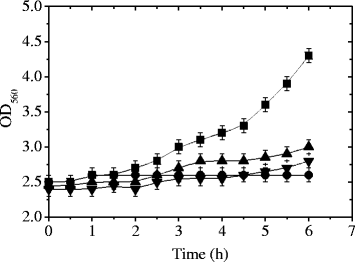Phage adsorption and lytic propagation in Lactobacillus plantarum: could host cell starvation affect them?
- PMID: 26627203
- PMCID: PMC4667525
- DOI: 10.1186/s12866-015-0607-1
Phage adsorption and lytic propagation in Lactobacillus plantarum: could host cell starvation affect them?
Abstract
Background: Bacteriophages constitute a great threat to the activity of lactic acid bacteria used in industrial processes. Several factors can influence the infection cycle of bacteriophages. That is the case of the physiological state of host cells, which could produce inhibition or delay of the phage infection process. In the present work, the influence of Lactobacillus plantarum host cell starvation on phage B1 adsorption and propagation was investigated.
Result: First, cell growth kinetics of L. plantarum ATCC 8014 were determined in MRS, limiting carbon (S-N), limiting nitrogen (S-C) and limiting carbon/nitrogen (S) broth. L. plantarum ATCC 8014 strain showed reduced growth rate under starvation conditions in comparison to the one obtained in MRS broth. Adsorption efficiencies of > 99 % were observed on the starved L. plantarum ATCC 8014 cells. Finally, the influence of cell starvation conditions in phage propagation was investigated through one-step growth curves. In this regard, production of phage progeny was studied when phage infection began before or after cell starvation. When bacterial cells were starved after phage infection, phage B1 was able to propagate in L. plantarum ATCC 8014 strain in a medium devoid of carbon source (S-N) but not when nitrogen (S-C broth) or nitrogen/carbon (S broth) sources were removed. However, addition of nitrogen and carbon/nitrogen compounds to starved infected cells caused the restoration of phage production. When bacterial cells were starved before phage infection, phage B1 propagated in either nitrogen or nitrogen/carbon starved cells only when the favorable conditions of culture (MRS) were used as a propagation medium. Regarding carbon starved cells, phage propagation in either MRS or S-N broth was evidenced.
Conclusions: These results demonstrated that phage B1 could propagate in host cells even in unfavorable culture conditions, becoming a hazardous source of phages that could disseminate to industrial environments.
Figures





References
-
- Carminati D, Giraffa G, Quiberoni A, Binetti A, Suárez V, Reinheimer J. Advances and trends in starter cultures for dairy fermentations. In: Mozzi F, Raya RR, Vignolo GM, editors. Biotechnology of lactic acid bacteria. Iowa: Blackwell Publishing; 2010. pp. 177–192.
Publication types
MeSH terms
Substances
LinkOut - more resources
Full Text Sources
Other Literature Sources
Molecular Biology Databases

